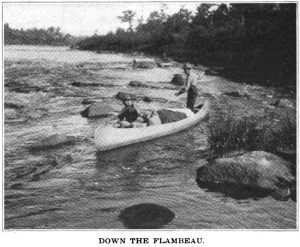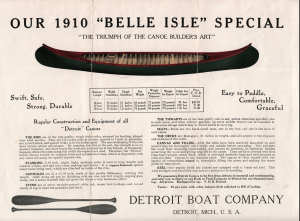By and Large
Welcome to Discovering the Northwoods from the Manitowish Waters Historical Society. We will take you on a journey through our local history with the help of primary source documentation. To learn more about this rich history or about the historical society – check out our website at mwhistory.org. There you will find blog posts, show notes, our YouTube Channel, and a full transcription of this episode, including maps and photographs.
As with many historical works from this era, there are phrases, terms, and descriptions that are inappropriate to our modern sensibilities. The Manitowish Waters Historical Society in no way condones these offensive remarks or passages. The original document is attached in the show notes if you’d like to read this publication in its entirety for educational purposes and accurate historical context.
By and Large is a story of a canoe voyage aboard a “Belle Isle” Special – Described in a 1910 advertisement as “The Triumph of the canoe builder’s art. Swift, Safe, Strong, Durable. Easy to paddle, comfortable, graceful.” From photographing timber wolves to baking pickerel over open coals, dodging rocks in roaring rapids, and drifting silently past deer on moonlit waters, this story isn’t just about travel — it’s about immersion. Into solitude. Into wildness. Into a different way of moving through the world, but all under the guise of an advertisement for an excellent canoe. This article was published in the Press of Atlantic City, New Jersey, in 1927, and the author is unknown.
Transcript
Press of Atlantic City (Atlantic City, NJ) – October 26, 1927
Start of a former sailor in a rowboat on a 1500 mile trip from New York to Miami yesterday brings back memories of a similar trip, years ago, in a 17-foot canoe, that took up come 4000 miles from Northern Wisconsin down to within a short distance of the Gulf of Mexico, where an attack of malaria brought an end to our expedition and, incidentally, the unofficial long-distance canoeing championship for 1914. It was an interesting trip, nevertheless, and the 18 months were crammed with experiences of one kind and another, duly recorded by camera and typewriter for a sportsman’s magazine. There being a number of canoe enthusiasts hereabouts, some recollections of the trip may prove interesting and help popularize the canoe as a means for an excellent vacation trip.
Having shipped our 17-foot Belle Isle to Manitowish, a little way-station in the northern-most part of Wisconsin, on a fine June morning, we launched our frail craft in the Manitowish River, nothing more than a creek, and proceeded south. Soon, the creek grew into a stream of deep and clear water and became the Flambeau River. Giant muskellunge and pickerel darted underneath the canoe, with the stumpier pike and other sweet-water fish easily discernible in the clear water. Our equipment for fishing, as well as hunting, was complete, and soon our spoon was humming through the water. Baked pickerel, baked in the coals of the campfire and wrapped in a clay covering, tasted good that night.
The territory was complete wilderness, and the nearest habitation was some hundred miles away. The tracks of bear, wolf, and deer were to be found on the riverbank, and both flora and fauna, being seldom disturbed by the hand of man, were both plentiful and varied. Deer were leisurely feeding on the wild rice in the water and, as the current here had a velocity of about 10 miles an hour, dexterous steering with the paddle brought us many times within a few feet of a fine buck, with antlers still covered with skin and hair. Some good close-ups were obtained here of deer, porcupine, marten, different varieties of ducks, and other waterfowl, and once a timber wolf photographed himself at his watering place by tripping the cord that released the camera shutter.

Down the Flambeau. Water Sports Magazine, December 1926. 2021.001.014
Guns and ammunition we had aplenty, of course, but except with the camera, there was no hunting. Other equipment consisted of extra paddles, blankets, a sheet-iron stove, a tent, and tent poles, completely filling the canoe and securely lashed. And, oh yes, there was “Jack,” our blank-and-white pointer, resting on the top of the load, an expert canoeist. “Jack” proved himself useful in many other ways, later, when June gave way to December, and possum, raccoon, and geese took the place of deer and summer duck.
We had been on our way two days, and soon the increasing current, necessitating little paddling, and a distant roar announced that we were nearing the rapids, the Flambeau being full of them and most of them being negotiated only by Indians and in long river bateaux. Picking our way among the rocks, as carefully as the 20-mile current would permit us, we negotiated most of the falls without mishap. The one [upset] came in jumping a little four-foot fall called “Potatoe Falls,” near the town of Park Falls, when the bow of the canoe struck a submerged rock and we were unceremoniously dumped in the water. Everything being lashed, we lost nothing but a small camera, and within an hour, everything was dried in the sun, and the journey proceeded.
Portaging around big falls camping every night, taking little side trips to some of the numerous lakes, enjoying the fishing, acquiring a sparrow hawk os a mascot, we took two weeks to make our way leisurely down the Flambeau and Chippewa rivers, past Ladysmith, Chippewa Falls, Durant and Trevino, where the broad Mississippi took us upon his bosom with his for mile current. Down the father of waters, into creeks, the Pocatonica and Rock rivers, back into the Mississippi, portaging over into the Little River, Big Lake, Arkansas, St. Francis, etc., is another interesting story.
The Advertisement
The article serves as a claim for the success of the “Belle Isle” canoe of 1910, created by the Detroit Boat Company. A 17-foot “Belle Isle” canoe, like the one used in the article before, would have cost $51 in 1910. To place that in context, based on a 1910 catalogue of the Capital Boat and Canoe Works, the price of similar style canoes ranged from $35 to $59. The following description of the “Belle Isle” canoe comes from an advertisement published by the Detroit Boat Company.
The Triumph of the canoe builder’s art. Swift, Safe, Strong, Durable. Easy to Paddle, Comfortable, Graceful.
The Ribs are of the best quality, tough white cedar, steamed for bending, shaped over solid moulds. They are 2 1.2 inches wide at the center, tapered to 1 inch at gunwales, are 3/8 inch thick, and spaced from 1 1/2 to 2 1/2 inches apart. The special shaping of the ribs manner impaired, and there is no tendency to round up at the bottom, as frequently happens when ribs containing full width throughout are used. Therefore, the “Detroit” Canoe always retains its original form and symmetrical lines, which is impossible with any canoe not using our special tapered ribs.
Planking – tough, light, northern cedar is used in long lengths and suitable widths, and laid very close, making tight joints. It is copper-fastened, special canoe tacks being used, which are clinched on inside of the ribs.
Gunwales – made of best quality Mahogany, running full length. After decks are put in, finishing rails are also run full length, capping gunwales, and a neatly finished side rail gives the whole a very handsome effect.
Stems are of select straight-grained white oak, steam-bent to shape, and curved neatly at top to meet the gunwales and deck.
The Thwarts are of the best quality oak or ash, unless otherwise specified, two in each canoe, and when ordered specially, an extra middle thwart can be installed at small extra charge which may be found useful in carrying.
Seats – there are two hard-caned seats, one in the bow and one in the stern of each canoe
Canvas and Filling – After the hulls have been carefully smoothed up and sanded, they are thoroughly oiled inside and outside before canvasing. This prevents the wood from becoming water-soaked, and ensures its retaining it lightness, besides preserving the wood and giving long life to the canoe. They are then covered with first-class heavyweight cotton duck, which is stretched perfectly tight and well fastened at ends and rails. Canvas is one seamless piece. The canvas is then treated with out special oil composition ironed in, thoroughly filling the pores, and making the canoe perfectly waterproof.
Keel – Our regular Bell Isle Canoes are equipped with a 1-inch oak keel. This adds strength and durability and acts as a protection in handling.
We guarantee Detroit Canoes to be free from defects in material and workmanship, and refer you to Dun’s or any Bunk or Trust Company in Detroit for our financial standing. All prices, burlapped in hay.
The Detroit Boat Company
The canoe is named after the park nestled in the Detroit River. Belle Isle Park is a 982-acre island park, one of the largest city-owned island parks in the United States. It’s home to lush woods, historic architecture, and winding canals that once made it a Midwestern paradise for canoeing.
Originally settled by French colonists in the 1700s and known then as Île aux Cochons, or Hog Island, Belle Isle has undergone many transformations. In 1879, the City of Detroit officially acquired it, and by the late 19th century, famed landscape architect Frederick Law Olmsted, best known for designing Central Park, was brought in to reimagine the island as a public escape from the bustling industrial city.
One of the island’s most iconic features became its man-made canals. Built between 1893 and 1910, these meandering waterways invited thousands to explore Belle Isle by canoe. By the early 1900s, canoeing was the pastime. A 1909 postcard even read, “Canoeing is the leading sport at Belle Isle, where light craft cruise about by the thousands.” Evenings were especially magical. Imagine gliding silently along a canal as a summer band concert echoed through the trees—a peaceful blend of nature, music, and community. This wasn’t just recreation. It was a shared experience, a ritual of city life that offered a reprieve from Detroit’s growing industrial grind.
A series of photographs from the Wooden Canoe Museum showcase a beautifully outfitted canoe, clearly designed for more than just paddling. It’s loaded with accessories, from soft pillows and backrests to a rope bumper wrapped around the side. Sitting proudly on the bow seat is a Victrola, ready to provide music for the outing. And no day on the water would be complete without a picnic lunch, tucked beside a young girl and her doll, ready to enjoy the adventure.
Belle Isle Park is a treasure trove of history. It is home to the Belle Isle Aquarium, the historic Anna Scripps Whitcomb Conservatory, the Dossin Great Lakes Museum, and the James Scott Memorial Fountain. There’s also a beach, a golf course, a Coast Guard station, and trails to explore on foot or by paddle. Connected to mainland Detroit by the MacArthur Bridge, Belle Isle still remains a gathering place for residents and visitors alike. Today, though motorboats and kayaks have joined the mix, canoeing is still relevant as it was in the 1927 article, By and Large.


